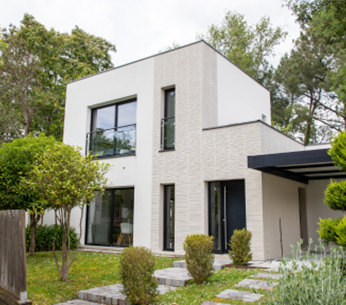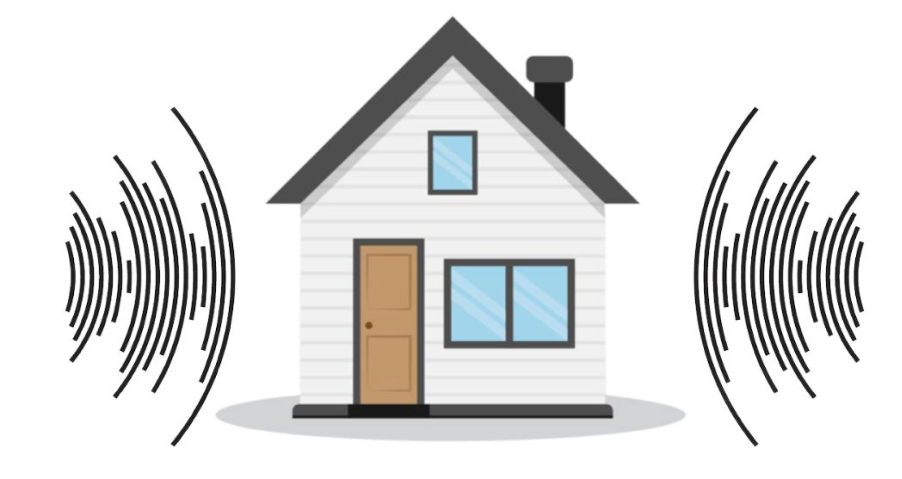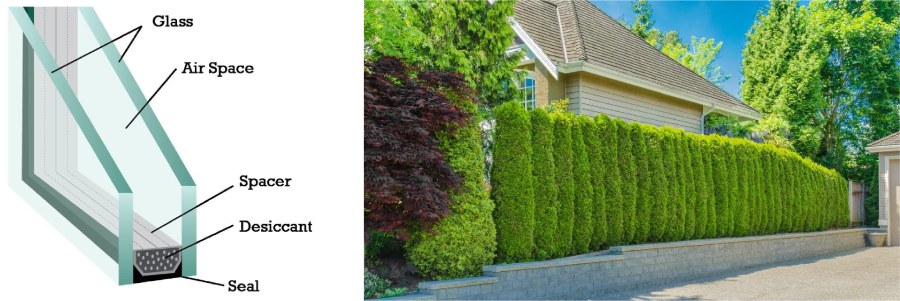
Module #6:
Sound issues from the outdoors
In the last module, we thoroughly analyzed indoor acoustic challenges, and solution options designed to mitigate noisy spaces, with the goal being to achieve sound comfort. Here we will address sound issues where sound originates from the outdoors.

We have all been in indoor spaces where we hear traffic, the hum of electrical equipment, or any number of undesirable sounds, and here are several ways that this unwanted sound can be either completely mitigated or at least reduced.
-
-
- Sound barriers: Installing sound barriers such as walls, fences, or vegetation can help to reduce the level of outdoor noise that enters a space. These barriers can be made from a variety of materials, such as concrete, wood, or vegetation, and can be designed to match the aesthetic of the surrounding environment.
- Soundproof windows and doors: Installing soundproof windows and doors can help to reduce the amount of outdoor noise that enters a space. These products are typically made from heavy-duty materials and are designed to block or absorb sound.
- Weather stripping and seals: Installing weather stripping and seals around windows and doors can help to reduce the amount of sound that enters a space by blocking sound from entering through gaps and cracks.
- Acoustic treatments: Adding sound-absorbing materials such as acoustic panels, ceiling tiles, or carpeting to a space can help to reduce reverberation and improve the sound quality of a space.
- Building design: Designing the layout of a space to optimize the acoustical properties can also help to reduce the level of outdoor noise that enters a space. For example, using angled walls, curved surfaces, or reflecting surfaces can help to scatter sound and reduce standing waves.
- Landscaping: Planting trees, bushes and other foliage can also help to reduce the level of outdoor noise that enters a space. This can be especially effective when combined with other methods such as sound barriers.
-

It’s important to note that when addressing sound issues from the outdoors, as is also the case with addressing indoor sound issues, the analysis is complex, and will inevitably require the consideration of many factors that include the intended use of the space, the acoustical properties of the materials used, and the specific requirements of the situation.
When it comes to designing for residential developments that are positioned close to the highway or a busy road, the US Department of Transportation recommends that when designing the floor plan for a residence, the architect or builder can place rooms that are less sensitive to noise (ie: kitchens, bathrooms, and laundry rooms) on the side of the home nearest the highway, opening up space farther from the road for bedrooms and living areas. The architect also can design the house so that it shields the backyard, which has no walls or roof itself to block traffic noise.
They also recommend other architectural considerations, such as:
- minimizing the number of windows and doors facing the highway
- installing double- or triple-paned glass windows and solid-core doors
- sealing areas around doors
- installing sound-deadening materials such as fiberglass insulation in walls
- increasing the building mass
- increasing the rigidity of materials used in construction, such as using brick or concrete instead of wood
- providing air spaces in walls, floors, and ceilings
- using rigid metal frame connectors in exterior walls not made of masonry to dampen vibrations from the exterior that may transmit through walls
- installing staggered studs, air conditioning, and noise dampers on air intakes. (((Per “Living with Noise”, by Chris Corbisier; July, August 2003)))
This culminates our overview on Acoustics and sound, how sound moves within space, what affects sound trajectory and its auditory absorption, and some general challenges and considerations based on the spaces being analyzed. Our next series will focus on specific areas and application types, a deep dive into some of the general locations referenced in Module #3. Here is an overview of what is to come: Module #7 Office environments, Module #8 Sound in Restaurants, Module #9 Sound in Schools, and Module #10 Sound in Hotels
